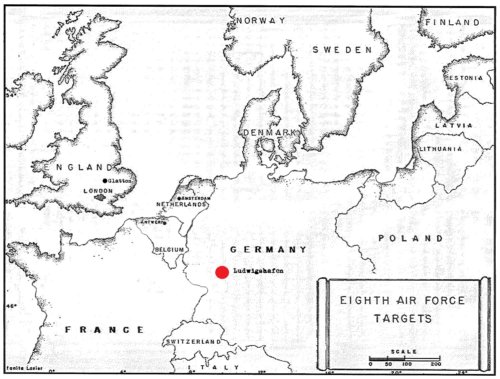MISSION NO. 52
LUDWIGSHAFEN, GERMANY
27 MAY, 1944

Six Combat Wings of the 1st Division were dispatched to the banks of the Rhine River to bomb the marshalling yards in the twin cities of Ludwigshafen and Mannheim. The 457th, as lead of the 94th A Combat Wing, led the Eighth Air Force in the procession to these targets. The 457th supplied thirty-six craft to form the lead and the low boxes in the Wing. Col. James R. Luper led as Air Commander with Lt. Charles D. Brannan as pilot. Captain Jacob M. Dickinson led the low box with Lt. Malcolm E. Johnson as pilot.
En route to the target, the Group fell victim of a massive frontal attack by Me-109s. The craft piloted by Lt. Artie J. Whitlow was hit on the right wing; a part of the wing came off and the No. 3 engine caught on fire. The ship went into a tight spiral before developing a spin. It crashed into a wooded area and exploded. Lt. Whitlow did not survive.
The craft piloted by Lt. William E. Dee was hit, dropped out of formation and headed back towards the Channel. One crewman was killed, the others became prisoners of war. Lt. Thomas E. Lee received direct hits and his engineer was killed instantly.
Lt. Roger W. Birkman’s and Lt. David K. Summerville’s planes were knocked out of formation. With an engine on fire and losing altitude, Lt. Birkman left the formation and the crew bailed out. Five of the crew were captured and became prisoners of war. The others evaded capture and later returned to England after the invasion.
Lt. Summerville returned to the base after having fires in three of his craft’s engines. Two engines were lost completely With the propeller breaking off of one engine, and the tins breaking off the other. He ultimately made a landing at Glat ton with limited power in only one engine.
The Luftwaffe attack lasted twenty-five minutes before it was brought to an end. The Group continued to the primary arget, bombing it with fair results. The Luftwaffe had succeeded in disrupting the formation, causing the low box to go in before the lead box. The lead box did a 360 degree turn and the second time around found the target covered with smoke that was rising thousands of feet in the air. Flak was heavy over the target area with thirteen aircraft receiving flak damage. To offset the losses, the 457th received credit for destroying one enemy aircraft and damaging five others.
Lt. Roy W. Allen came in to land only to discover one landing gear would not come down. Rather than attempt a belly landing, he chose to attempt a one wheel landing. He touched down, kept the wing up as long as possible, and concluded with a 180 degree ground loop. There were no injuries.
(Compiler Note: For Lt. Dave Summerville account of the mission, see Chapter 19.)
